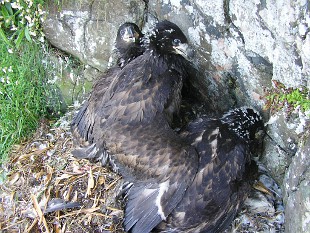
Sea eagle triplets on Canna (Photo: Justin Grant)
Conservationists have confirmed that on the Island of Canna in the Inner Hebrides, triplets have fledged – only the second time that this has been recorded in Scotland.
Meanwhile, a chick raised by the resident sea eagle pair on Shieldaig Island in Wester Ross recently took its maiden flight.
At both sites, the Trust works in partnership with local RSPB Scotland experts to monitor the birds. On Canna, experienced climbers abseil down a huge sea cliff to weigh and ring the chicks.
White-tailed eagles, or sea eagles became extinct from the UK in the early 20th century, largely due to human killing. In 1975, conservationists including RSPB Scotland and Scottish Natural Heritage, began returning the species to its former range by reintroducing them to the island of Rum. This was followed by similar reintroductions in Wester Ross in 1993, and most recently in East Scotland in 2007. The latest figures from RSPB Scotland for 2010 found there were 52 breeding sea eagle pairs in Scotland.
National Trust for Scotland Senior Nature Conservation Adviser Dr Richard Luxmoore said: “We are particularly pleased that the Canna sea eagles have fledged three chicks, a very rare occurrence in Scotland. They have a very consistent breeding success, having been one of the first nest sites following their release on the neighbouring island of Rum.”
Alison Maclennan, RSPB Scotland Conservation Officer for Skye, Wester Ross and Lochalsh, added: “With the exception of a few decades in the 20th century, the white-tailed sea eagle has been part of our landscape in the west of Scotland for thousands of years. It’s great to see them thriving in their old haunts again and to see the tremendous enjoyment and interest they are providing locally, over and above the tourism benefits they are bringing.”
